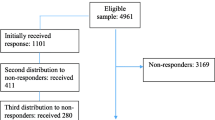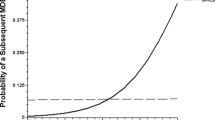Abstract
The correlates of self-rated depressive symptoms were examined in an epidemiological sample of Swiss adolescents. Subjects, aged 12 to 17 years, were assessed using the Center for Epidemiological Studies Depression Scale, a Life Event Scale, scales measuring self-related cognitions, coping capacities, perceived parental behavior, school environment, and social network. Based on the distribution of the depression scores, 3 subsamples of nondepressed, moderately depressed, and severely depressed subjects were formed. The severely depressed group was clearly differentiated from the other two groups by almost all scales, with a special relevance of negative self-esteem and the impact of life events. The results of this epidemiological study indicate that various factors reflecting personality, life-events, and the psychosocial environment relate to adolescent depression.
Similar content being viewed by others
REFERENCES
Block, J., and Gjerde, P. F. (1990). Depressive symptoms in late adolescence: A longitudinal perspective on personality antecedents. In Rolf, J., Masten, A. S., Cicchetti, D., Nuechterlein K. H., and Weintraub, S. (ed.), Risk and Protective Factors in the Development of Psychopathology. Cambridge University Press, New York, pp. 334–360.
Cohen, S., and Wills, T. A. (1985). Stress, social support, and the buffering hypothesis. Psychol. Bull. 98: 310–357.
Compas, B. E. (1987). Coping with stress during childhood and adolescence. Psychol. Bull. 101: 393–403.
Compas, B. E., Malcarne, V. L., and Fondacaro, K. M. (1988). Coping with stressful events in older children and young adolescents. J. Consult. Clin. Psychol. 56: 405–411.
Faulstich, M. E., Carey, M. P., Ruggiero, L., Enyart, P., and Gresham, F. (1986). Assessment of depression in childhood and adolescence: An evaluation of the center for epidemiological studies depression scale for children (CES-DC). Am. J. Psychiat. 143: 1024–1027.
Fend, H., and Prester, H.-G. (1986). Bericht aus dem Projekt “Entwicklung im Jugendalter” [Report from the project “Development in adolescence”] (in German). Faculty of Social Sciences, University of Constance, Germany.
Filipp, S.-H. (1990). Lebensereignisforschung—eine Bilanz. In Filipp, S.-H. (ed.), Kritische Lebensereignisse. Psychologie Verlags Union, München, pp. 2293–2326.
Filipp, S.-H., and Freudenberg, E. (1989). Der Fragebogen zur Erfassung dispositionaler Selbstaufmerksamkeit [Questionnaire for the Assessment of Dispositional Self-Awareness] (in German) Hogrefe, Göttingen.
Ge, X., Lorenz, F. O., Conger, R. D., Elder, G. H., Jr., and Simons, R. L. (1994). Trajectories of stressful life events and depressive symptoms during adolescence. Develop. Psychol. 30: 467–483.
Goodyer, I. M. (1990). Life Experiences, Development and Childhood Psychopathology. Wiley, Chichester.
Goodyer, I. M., and Altham, P. M. E. (1991). Lifetime exit events and recent social and family adversities in anxious and depressed school-age children and adolescents—II. J. Affective Disord. 21: 229–238.
Hammen, C. (1992). Cognitive, life stress, and interpersonal approaches to a developmental psychopathology model of depression. Develop. Psychopathol. 4: 189–206.
Harter, S. (1990). Self and identity development. In Feldman, S. S., and Elliott, G. R. (ed.), At the Threshold. The Developing Adolescent. Harvard University Press, Cambridge, MA, pp. 352–387.
Hautzinger, M., and Bailer, M. (1993). Allgemeine Depressions-Skala (ADS) [German version of the Center for Epidemiological Studies Depression Scale (CES-D) Allgemeine Depressions-Skala (ADS)] (in German). Beltz, Weinheim.
Hull, J. G. (1981). A self-awareness model of the causes and effects of alcohol consumption. J. Abnorm. Psychol. 90: 596–600.
Jorgensen, R. S., and Dusek, J. B. (1990). Adolescent adjustment and coping strategies. J. Personality 58: 503–513.
Kashani, J. H., and Schmid, L. S. (1992). Epidemiology and etiology of depressive disorders. In Shafii, M., and Shafii, S. L. (eds.), Clinical Guide to Depression in Children and Adolecents. American Psychiatric Press, Inc., Washington, DC, pp. 43–64.
Lewinsohn, D. M., Rohde, P., and Seeley, J. R. (1998). Major depressive disorder in older adolescents: Prevalence, risk factors, and clinical implications. Clin. Psychol. Rev. 18: 765–794.
Lewinsohn, P. M., Gotlib, I. H., and Seeley, J. R. (1995). Adolescent psychopathology: IV. Specificity of psychosocial risk factors for depression and substance abuse in older adolescents. J. Am. Acad. Child Adolesc. Psychiat. 34: 1221–1229.
Lewinsohn, P. M., Hops, H., Roberts, R. E., Seeley, J. R., and Andrews, J. A. (1993). Adolescent psychopathology: I. Prevalence and incidence of depression and other DSM-III-R disorders in high school students. J. Abnorm. Psychol. 102: 133–144.
Lewinsohn, P. M., Roberts, R. E., Seeley, J. R., Rohde, P., Gotlib, I. H., and Hops, H. (1994). Adolescent psychopathology: II. Psychosocial risk factors for depression. J. Abnorm. Psychol. 103: 302–315.
McCrae, R. R., and Costa, P. T., Jr. (1986). Personality, coping and coping effectiveness in an adult sample. J. Personality 54: 385–405.
Patterson, G. R., and Capaldi, D. M. (1990). A mediational model for boys' depressed mood. In Rolf, J., Masten, A. S., Cicchetti, K. H., Nuechterlein, K. H., and Weintraaub, S. (eds.), Handbood of Developmental Psychopathology. Plenum Press, New York, pp. 341–351.
Putallaz, M., and Dunn, S. E. (1990). The importance of peer relations. In Lewis, M., and Miller, S. M. (eds.), Handbook of Developmental Psychopathology. Plenum Press, New York, pp. 227–236.
Radloff, L. S. (1977). The CES-D scale: A self-report depression scale for research in the general population. Appl. Psychological Measurement 1: 385–401.
Rapee, R. M. (1997). Potential role of childrearing practices in the development of anxiety and depression. Clinical Psychol. Rev. 17: 47–67.
Rehm, L. P., and Carter, A. S. (1990). Cognitive components of depression. In Lewis, M., and Miller, S. M. (eds.), Handbook of Developmental Psychopathology. Plenum Press, New York, pp. 341–351.
Renouf, A. G., and Harter, S. (1990). Low self-worth and anger as components of the depressive experience in young adolescents. Develop. Psychopathol. 2: 293–310.
Roberts, R. E., Andrews, J. A., Lewinsohn, P. M., and Hops, M. (1990). Assessment of depression in adolescents using the Center for Epidemiologic Studies Depression Scale. Psychol. Assess.: J. Consult. Clin. Psychol. 2: 122–128.
Roberts, R. E., Lewinsohn, P. M., and Seeley, J. R. (1991). Screening for adolescent depression: A comparison of depression scales. J. Am. Acad. Child Adolesc. Psychiat. 30: 58–66.
Rosenberg, M. (1965). Society and the Adolescent Self-Image. Princeton University Press, Princeton.
Rosenberg, M. (1979). Society and the Adolescent Self-Image. Basic, New York.
Rutter, M. (1995). Causal concepts and their testing. In Rutter, M., and Smith, D. J. (eds.), Psychosocial Disorders in Young People: Time Trends and Their Causes. John Wiley and Sons, Chichester, pp. 7–34.
Rutter, M., and Cox, A. (1985). Other family influences. In Rutter, M., and Hersov, L. (eds.), Child and Adolescent Psychiatry—Modern Approaches. Blackwell, Oxford, pp. 58–81.
Schaefer, E. S. (1965). Children's reports of parental behavior: An inventory. Child Dev. 36: 417–424.
Schludermann, E., and Schludermann, S. (1970). Replicability of factors in children's report of parent behavior (CRPBI). J. Psychol. 76: 239–249.
Seiffge-Krenke, I. (1989). Bewältigung alltäglicher Problemsituationen: Ein Coping-Fragebogen für Jugendliche [Coping with everyday problem situations: A coping questionnaire for adolescents] (in German). Zeitschrift für Differentielle und Diagnostische Psychologie. 10: 201–220.
Siegelman, M. (1965). Evaluation of Bronfenbrenner's questionnaire for children concerning parental behavior. Child Dev. 36: 163–174.
Steinhausen, H.-C., Winkler, C., and Meier, M. (1997a). Eating disorders in adolescence in a Swiss epidemiological study. Int. J. Eating Disord. 22: 147–151.
Steinhausen, H.-C., and Winkler Metzke, C. (1998a). Frequency and correlates of substance use among preadolescents and adolescents in a Swiss epidemiological study. J. Child Psychol. Psychiat. 39: 387–397.
Steinhausen, H.-C., and Winkler Metzke, C. (1998b). Youth self report of behavioral and emotional problems in a Swiss epidemiological study. J. Youth Adolesc. 27: 425–441.
Steinhausen, H.-C., Winkler Metzke, C., Meier, M., and Kannenberg, R. (1998). Prevalence of child and adolescent psychiatric disorders: The Zürich Epidemiological Study. Acta. Psychiatr. Scand. 98: 262–271.
Steinhausen, H. C., Winkler Metzke, C., Meier, M., and Kannenberg, R. (1997b). Behavioral and emotional problems reported by parents for ages 6 to 17 in a Swiss epidemiological study. Eur. Child Adolesc. Psychiat. 6: 136–141.
Williamson, D. E., Birmaher, B., Anderson, B. P., Al-Shabbout, M., and Ryan, N. D. (1995). Stressful life events in depressed adolescents: The role of dependent events during the depressive episode. J. Am. Acad. Child Adolesc. Psychiat. 34: 591–598.
Wolkind, S., and Rutter, M. (1985a). Separation, loss and family relationships. In Rutter, M., and Hersov, L. (eds.), Child and Adolescent Psychiatry—Modern Approaches. Blackwell Scientific Publications, Oxford, pp. 34–57.
Wolkind, S., and Rutter, M. (1985b). Sociocultural factors. In Rutter, M., and Hersov, L. (eds.), Child and Adolescent Psychiatry—Modern Approaches. Blackwell Scientific Publications, Oxford, pp. 82–100.
Author information
Authors and Affiliations
Rights and permissions
About this article
Cite this article
Steinhausen, HC., Metzke, C.W. Adolescent Self-Rated Depressive Symptoms in a Swiss Epidemiological Study. Journal of Youth and Adolescence 29, 427–440 (2000). https://doi.org/10.1023/A:1005106409022
Issue Date:
DOI: https://doi.org/10.1023/A:1005106409022




